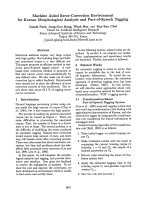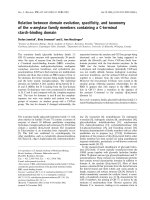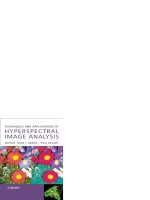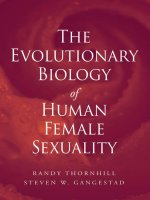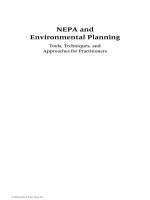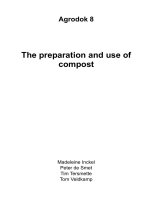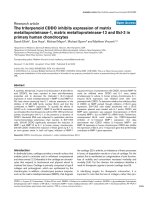MODERN MORPHOLOGICAL TECHNIQUES AND THE EVOLUTIONARY BIOLOGY AND TAXONOMY OF SEPSIDAE (DIPTERA) 1
Bạn đang xem bản rút gọn của tài liệu. Xem và tải ngay bản đầy đủ của tài liệu tại đây (3.93 MB, 102 trang )
MODERN MORPHOLOGICAL TECHNIQUES AND
THE EVOLUTIONARY BIOLOGY AND
TAXONOMY OF SEPSIDAE (DIPTERA)
YUCHEN ANG
(B.Sc. (Hons), NUS)
DEPARTMENT OF BIOLOGICAL SCIENCES
NATIONAL UNIVERSITY OF SINGAPORE
2013
MODERN MORPHOLOGICAL TECHNIQUES AND
THE EVOLUTIONARY BIOLOGY AND
TAXONOMY OF SEPSIDAE (DIPTERA)
YUCHEN ANG
(B.Sc. (Hons), NUS)
A THESIS SUBMITTED FOR THE DEGREE OF
DOCTOR OF PHILOSOPHY
DEPARTMENT OF BIOLOGICAL SCIENCES
NATIONAL UNIVERSITY OF SINGAPORE
2013
DECLARATION
I hereby declare that this thesis is my original work and it has been written by
me in its entirety. I have duly acknowledged all the sources of information
which have been used in the thesis.
This thesis has also not been submitted for any degree in any university
previously.
___________________
Yuchen Ang
16 August 2013
2
ACKNOWLEDGEMENTS
The first person I must thank would have to be my supervisor and long-time
mentor, Prof. Dr. Rudolf Meier. I have known The Teutonic Terror of S2 for close to
nine years now, having been under his wing for both my B.Sc. and current Ph.D. In this
time, I have benefitted so much, learning from him the ‘tools of the trade’, and his
frank, critically constructive feedback has only helped to toughen my already-thick
hide and more importantly develop my own set of critical thinking skills. Through
numerous ‘coffee breaks’ and a lot of cajoling and nudging, I managed to get through
and tackle the great academic Ph.D. beast. Sometimes I feel undeserving of all the trust,
opportunities and help that he has given me, and ll this I am grateful for – especially his
contagious passion in research and sepsids that I have contracted as well. Summarily I
would liken him to the Gordon Ramsay of Science: doing research under him is tough
and a little frightening because he demands so much, but ultimately, much more
rewarding and inspiring as he imparts his knowledge and attitude that helps you
achieve your own potential. Thank you Prof, this time I’m writing it for you.
Next of course are my labmates whom I’ve come a long way with: Amrita,
coding sleuth and occasional stats-tutor whom Sepsidnet and I are so in debt with for
all the prompt and late-night help – I owe you so much tea now! Denise ‘Little-Red’
Tan, old-bird Mammafly with all the crazy long work-fevered nights we’ve shared, I’m
glad you’ve found a way to permanently damage your head in Florida ☺ (sorry I
couldn’t make it to your mega-sendoff all because of this). Kathy Su, I’m glad you’ve
come back to evolab – it’s good to have a Science-first author doctor around in the
consultation room pantry that I can rely on to critically examine my work, and also
listen to my yammerings. Diego, for all the innuendo jokes and bouncing off interesting
3
ideas – it really energizes me to explore more in my work. Ahlek Wong, I really
appreciate all the help in the Chiro project rearing and stuff, sorry if I’m a little slow
with the imaging. Jay, always with cookies and chips, please make more of that yummy
dessert you being to lab. Lei, Mindy, Youguang, Nesibe, Ivy, Darren, plus all the others
who have left the lab, all you guys and girls have made the lab the quirky and fun place
to work in!
Of course, I cannot forget my loved ones, who have made so many sacrifices; I
really would not have made it here without your support. Ma and Pa, thank you for all
the support in so many different ways you have given me; all your expressed worries I
do consider carefully, so try not to worry. Thank you for being so understanding about
my regular late nights and not expecting me to pay the bills even when I’m already 30.
I’m going to get an income soon. A job. With CPF. Promise! Mei, thanks for always
offering to give me a lift home, both you and Di do brighten my day with your silly
antics and stupid 9GAG posts, specifically, “HEHEUHEHAHEAHUEH”. Grace, I’m
sorry you’ve had to tolerate my crazy work-life schedule and thank you for all the care
you’ve showered, all the little welfare packages of food and more snacks, coming all
the way from the East to deliver hot food. And especially for that final push where you
just pushed me on so much more. I’m sorry it had to come to this.
4
Table of Contents
THESIS SUMMARY 7
List of Figures 8
List of tables, videos and appendices 10
List of publications used in this thesis 11
List of species used in this thesis 12
CHAPTER 1: General Introduction 16
A plea for morphology in biology 16
Evolutionary biology and taxonomy of Sepsidae 19
CHAPTER 2: Phylogenetic origins and morphological evolution of the sepsid
sternite appendage 23
Abstract 23
Introduction 25
Part I: The evolutionary origins of the sternite appendages in the Sepsidae
27
Materials and Methods 27
Results and Discussion 29
Part II: Co-option of muscles and sternites for the formation of the sepsid
sternite appendage 37
Materials and Methods 38
Results 39
Discussion 48
Appendix 1A 50
Appendix 1B 54
5
CHAPTER 3: Male sepsid legs evolve rapidly when in direct contact with
female structures 55
Abstract 55
Introduction 56
Materials and Methods 62
Results 66
Discussion 73
Appendix 2A 77
Appendix 2B 81
CHAPTER 4: A plea for digital reference collections and other science‐based
digitization initiatives in taxonomy: Sepsidnet as exemplar 82
Abstract 82
Introduction 83
Digital reference collections 86
Building the digital reference collection for Sepsidae 93
Conclusion 99
CHAPTER 5: Using seemingly unnecessary illustrations to improve the
diagnostic usefulness of descriptions in taxonomy 101
Abstract 101
Introduction 103
Materials and Methods 106
Results 108
Appendix 3 127
6
CHAPTER 6: Using multiple data-sources to address taxonomic uncertainties
128
Abstract 128
Part I: From ‘cryptic species’ to integrative taxonomy – an iterative process
involving DNA sequences, morphology, and behaviour leads to the resurrection of
Sepsis pyrrhosoma (Sepsidae: Diptera) 129
Materials and Methods 132
Results 135
Discussion 145
Conclusion 148
Part II: Morphology and DNA sequences confirm the first Neotropical record
for the Holarctic sepsid species Themira leachi (Meigen) (Diptera: Sepsidae)149
Materials and Methods 150
Results and Discussion 150
CHAPTER 7: Increasing taxonomic data accessibility by linking wiki-entries
to species descriptions 155
Abstract 155
Introduction 156
Materials and Methods 159
Results 160
Key to species of the genus Perochaeta Duda, 1926 (males) 177
Discussion 178
THESIS CONCLUSIONS 181
References 185
7
THESIS SUMMARY
In my thesis, I pursue my research interests in morphology by conducting a
series of studies on the evolutionary biology and taxonomy of Sepsidae (Diptera), using
various bioimaging techniques such as microcomputered tomography,
photomicrography and scanning electron-microscopy. First, I document how de-novo
moveable appendages evolved from male sternites and show that it evolved twice in
sepsids. Second, I demonstrate that sexual selection highly increases morphological
divergence by quantifying and comparing the rates of evolution between sexually
dimorphic structures that are likely to be under sexual selection and monomorphic
structures that are mostly under viability selection. Third, I explore the benefits of
coupling taxonomy with information technology by creating a digital reference
collection featuring 140 sepsid species and a web-tool for online species identification,
as well as publishing species descriptions that are simultaneously featured as taxonomic
entries in a wiki-based platform. Lastly, I show how morphological data-richness and
iterative taxonomy can address inadequately diagnostic species descriptions as well as
resolve 'cryptic' species proposed based on DNA sequences as well as disjunctive
distributions in species.
8
List of Figures
Figure 1.1: Phylogenetic hypothesis of Sepsidae used in this study for Chapter 2 31
Figure 1.2: Phylogenetic hypothesis of Sepsidae parsimony and maximum likelihood
support that appendages evolved twice and were lost three times 32
Figure 1.3A: Summary of female sternites across Sepsidae 33
Figure 1.3B: Summary of male sternites across Sepsidae 34
Figure 1.4. Photomicrographs of ventral abdomen with expanded view of sternites 4
and 5, for Saltella sphondylli male, Themira lucida male, Themira superba male
and Themira superba female, as well as the habitus of T. superba male 41
Figures 1.5 – 1.7 (Part 1): Three dimensional models showing various views
for Saltella sphondylli male, Themira lucida male and Themira superba male (Views
A-B) 44
Figures 1.5 – 1.7 (Part 2): Three dimensional models showing various views
for Saltella sphondylli male, Themira lucida male and Themira superba male (Views
C-E) 45
Figure 1.8: Three dimensional models showing various views for Themira superba
female 46
Figure 1.9: 3D model schematic of relevant structures in Themira superba explaining
how VM5-6 powers the arm 'raise' 46
Figure 2.1: ‘Wing clasp’ behavior in various sepsid species 60
Figure 2.2: Various ‘basitarsal thumbs’ in Coelopidae 61
Figure 2.3: Obtaining complexity scores from leg structures 65
Figure 2.4 (part 1): Forefemora and –tibiae for male and female sepsids, mapped onto
the sepsid phylogenetic hypothesis 67
Figure 2.4 (part 2): Midfemora and –tibiae for male and female sepsids, mapped onto
the sepsid phylogenetic hypothesis 68
Figure 2.5: Femora and tibiae for fore- and midlegs of male and female coelopids,
mapped onto the coelopid phylogenetic hypothesis 69
Figure 2.6: graphical representation of tree length for various leg structures of and
regions of sepsid males and females for quantitative and qualitative measures 71
Figure 2.7: graphical representation of tree lengthfor various leg structures of and
regions of coelopid males and females for quantitative and qualitative measures 71
9
Figure 3.1: Image of Nemopoda speiseri as seen in Zoomify™ viewer, showing the
habitus, lateral view (a); abdomen, ventral view (b); and dissected hypopygial capsule,
dorsal view (c) … 94
Figure 3.2: Image of male Sepsis cynipsea fore femur and tibia (partial), anterior
view 95
Figure 3.3: A visual guide to using Sepsidnet 97
Figure 4.1: Key views and structures of Perochaeta orientalis, Male 109
Figure 4.2: Key views and structures of Perochaeta orientalis, Female 110
Figure 4.3: Additional views for Perochaeta orientalis, Male and Female 111
Figure 4.4: Images of holotype and drawing from description for Perochaeta
orientalis, male 112
Figure 4.5: Copulatory profile for Perochaeta orientalis 119
Figure 4.6: Illustration of Archisepsis phallus, as reproduced from Eberhard and Huber
(1998) 123
Figure 5.1: Consensus tree of Sepsis flavimana group 136
Figure 5.2: Male and female Sepsis pyrrhosoma 137
Figure 5.3: Morphology of Themira leachi from Cuba 152
Figures 6.1 - 6.14: Various Perochaeta structures 162
Figures 6.15 – 6.23: Various Sepsis forelegs and hypopygia 170
Figures 6.24 - 6.31: Male Sepsis spura 173
10
List of tables, videos and appendices
Table 1.1: State optimizations for nodes on ML tree (Proportional likelihoods) and
bootstrap trees (remaining columns) 35
Table 2.1: Tree lengths indicating amount of evolutionary change for mid and forelegs
of sepsids and coelopids………… 70
Table 4.1: A summary of the pairwise distances between the COI of P. orientalis with
that of P. cuirassa (KF199839), P. dikowi (KF199840) and P. lobo (KF199841) 122
Table 5.1: Uncorrected pairwise genetic distances between and within and between
Sepsis flavimana and S. pyrrhosoma morphotypes 139
Table 5.2: Qualitative comparison of behavioural elements observed in Sepsis
flavimana and Sepsis pyrrhosoma (virgin) mating trials 140
Table 5.3: Results of the hybridization experiments in Sepsis flavimana and Sepsis
pyrrhosoma 140
Video 1: Video montage for the various behaviours in Perochaeta orientalis 118
Appendix 1A 50
Appendix 1B 54
Appendix 2A 77
Appendix 2B 81
Appendix 3 127
11
List of publications used in this thesis
(Listed in order of appearance)
Bowsher JH, Ang YC, Ferderer T, Meier R (2012) Deciphering the evolutionary
history and developmental mechanisms of a complex sexual ornament: the abdominal
appendages of Sepsidae (Diptera). Evolution 67(4), 1069-1080… Chapter 2.1
Ang YC, Puniamoorthy J, Pont AC, Bartak M, Blanckenhorn WU, Eberhard WG,
Puniamoorthy N, Silva VC, Munari L, Meier R (2013) A plea for digital reference
collections and other science‐based digitization initiatives in taxonomy: Sepsidnet as
exemplar. Systematic Entomology 38(3), 637-644……………… … Chapter 4
Ang YC, Meier R (2010) Five additions to the list of Sepsidae Diptera for Vietnam:
Perochaeta cuirassa sp. n., Perochaeta lobo sp. n., Sepsis spura sp. n., Sepsis sepsi
Ozerov, 2003 and Sepsis monostigma Thompson, 1869. ZooKeys, 70, 41-
56………………………………………………………………… Chapter 5.1
Tan DS, Ang YC, Lim GS, Ismail MRB, Meier R (2010) From ‘cryptic species’ to
integrative taxonomy: an iterative process involving DNA sequences, morphology, and
behaviour leads to the resurrection of Sepsis pyrrhosoma (Sepsidae: Diptera).
Zoologica Scripta 39, 51-61……………………………… Chapter 7.1
Ang YC, Lim GS, Meier, R (2008). Morphology and DNA sequences confirm the first
Neotropical record for the Holarctic sepsid species Themira leachi (Meigen) (Diptera:
Sepsidae). Zootaxa 1933, 63-6…………… Chapter 7.2
12
List of species used in this thesis
Sepsidae (Diptera, Acalyptrate)
No.
Species Name
Author
Used in Chapter(s)
1
Adriapontia capensis
(Hennig 1960)
3,4
2
Adriapontia freidbergi
Ozerov 2000
4
3
Adriapontia ihongeroensis
(Vanshuytbroeck 1963)
4
4
Adriapontia kyanyanmaensis
(Vanshuytbroeck 1963)
4
5
Afromeroplius semlikiensis
(Vanshuytbroeck 1963)
4
6
Afromeroplius watalingaensis
(Vanshuytbroeck 1963)
4
7
Afronemopoda ealaensis
(Vanshuytbroeck 1962)
4
8
Afrosepsis sublateralis
(Vanshuytbroeck 1962)
4
9
Allosepsis indica
(Wiedemann 1824)
2,3,4
10
Allosepsis testacea
(Walker 1860)
4
11
Archisepsis armata
(Schiner 1868)
2,4
12
Archisepsis discolor
(Bigot 1857)
2,4
13
Archisepsis diversiformis
(Ozerov 1993)
2,4
14
Archisepsis ecalcarata
(Thompson 1869)
2,4
15
Archisepsis excavata
(Duda 1926)
4
16
Archisepsis pleuralis
(Coquillet 1904)
2,4
17
Archisepsis priapus
Silva 1993
2,4
18
Archisepsis pusio
(Schiner 1868)
2,4
19
Archisepsis scabra
(Loew, 1861)
2
20
Brachythoracosepsis butikensis
(Vanschuytbroeck 1963)
4
21
Brachythoracosepsis freidbergi
Ozerov 1996
4
22
Brachythoracosepsis pseudonotosa
(Ozerov 1990)
3,4
23
Brachythoracosepsis ruanoliensis
(Vanschuytbroeck 1963)
3,4
24
Brachythoracosepsis saothomensis
Ozerov 2000
4
25
Decachaetophora aeneipes
(de Meijere 1913)
3,4
26
Dicranosepsis bicolor
(Wiedemann 1830)
4
27
Dicranosepsis crinita
(Duda 1926)
2,4
28
Dicranosepsis distincta
Iwasa et Tewari 1990
2,4
29
Dicranosepsis emiliae
Ozerov 1992
2,4
30
Dicranosepsis hamata
(de Meijere 1911)
2,4
31
Dicranosepsis javanica
(de Meijere 1904)
2,4
32
Dicranosepsis olfactoria
Iwasa 1984
2,4
33
Dicranosepsis papuana
Ozerov 1997
2,4
34
Dicranosepsis planitarsis
Ozerov 1994
4
35
Dicranosepsis takoensis
(Vanschuytbroeck 1963)
4
36
Dicranosepsis unipilosa
(Duda 1926)
2,4
37
Dicranosepsis "fake revocans"
-
2,3
38
Dicranosepsis "c.f. revocans"
-
2,3
39
Leptomerosepsis improvisa
Ozerov 1996
4
40
Leptomerosepsis ruwenzoriensis
(Vanchuytbroeck 1963)
4
13
41
Leptomerosepsis simplicicrus
(Duda 1926)
3,4
42
Meropliosepsis sexsetosa
Duda 1926
3,4
43
Meroplius alberquerquei
Silva 1990
3,4
44
Meroplius fasciculata
(Brunetti 1910)
2,3,4
45
Meroplius fukuharai
(Iwasa 1984)
2,3,4
46
Meroplius hastifer
S eguy 1938
4
47
Meroplius minutus
(Wiedemann 1830)
2,3,4
48
Microsepsis armillata
(Melander et Spuler 1917)
2,3,4
49
Microsepsis furcata
(Melander et Spuler 1917)
2,3,4
50
Microsepsis mitis
(Curran 1927)
3,4
51
Nemopoda nitidula
(Fall en 1820)
2,3,4
52
Nemopoda speiseri
(Duda 1926)
3,4
53
Ortalischema albitarse
(Zetterstedt 1847)
2,4
54
Orygma luctuosum
Meigen 1830
2,4
55
Palaeosepsioides erythromyrmus
(Silva 1991)
4
56
Palaeosepsis bucki
Ozerov 2004
4
57
Palaeosepsis dentata
(Becker 1919)
4
58
Palaeosepsis golovastik
Ozerov 2004
4
59
Parapalaeosepsis apicalis
(de Meijere 1906)
2,3,4
60
Parapalaeosepsis basifera
(Walker 1859)
4
61
Parapalaeosepsis compressa
Zuska 1970
4
62
Parapalaeosepsis limbata
(de Meijere 1906)
4
63
Parapalaeosepsis plebeia
(de Meijere 1906)
2,3,4
64
Paratoxopoda akuminambili
Vanshuytbroeck 1961
4
65
Paratoxopoda akuminamoya
Vanshuytbroeck 1961
4
66
Paratoxopoda amonane
Vanschuytbroek 1961
2,3,4
67
Paratoxopoda asaba
Vanshuytbroeck 1961
4
68
Paratoxopoda asita
Vanshuytbroeck 1961
4
69
Paratoxopoda barbata
Ozerov 1993
4
70
Paratoxopoda depilis
(Walker 1849)
2,3,4
71
Paratoxopoda kilinderensis
(Vanshuytbroeck 1963)
4
72
Paratoxopoda saegeri
(Vanshuytbroeck 1961)
4
73
Paratoxopoda similis
Ozerov 1993
3,4
74
Paratoxopoda straeleni
Vanshuytbroeck 1961
4
75
Paratoxopoda zuskai
Ozerov 1993
4
76
Perochaeta cuirassa
Ang 2010
4,5,7
77
Perochaeta dikowi
Ang et. al 2008
2,3,4,5
78
Perochaeta hennigi
Ozerov 1992
4
79
Perochaeta lobo
Ang 2010
4,5,7
80
Perochaeta orientalis
(de Meijere 1913)
3,4,5
81
Pseudopalaeosepsis nigricoxa
Ozerov 1992
4
82
Platytoxopoda sp.
-
3
83
Saltella nigripes
Robineau-Desvoidy 1830
2,4
84
Saltella sphondylii
(Schrank 1803)
2,3,4
85
Saltella sp.
-
2
86
Sepsis arotrolabis
Duda 1926
3,4
14
87
Sepsis barbata
Becker 1907
4
88
Sepsis biflexuosa
Strobl 1893
2,3,4
89
Sepsis coprophila
de Meijere 1806
4
90
Sepsis cynipsea
(Linnaeus 1758)
2,3,4
91
Sepsis defensa
Ozerov 1985
4
92
Sepsis dissimilis
Brunetti 1910
2,3,4
93
Sepsis duplicata
Haliday 1838
2,4
94
Sepsis fissa
Becker 1903
2,3,4
95
Sepsis flavimana
Meigen 1826
2,3,4
96
Sepsis frontalis
Walker 1860
2,3,4
97
Sepsis fulgens
Meigen 1826
2,3,4
98
Sepsis kalongensis
Vanshuytbroeck 1963
4
99
Sepsis kiribatensis
Vanshuytbroeck 1963
4
100
Sepsis kyandolirensis
Vanshuytbroeck 1963
4
101
Sepsis lateralis
Weidemann 1830
2,3,4
102
Sepsis latiforceps
Duda 1926
2,3,4,7
103
Sepsis hirsuta
de Meijere 1906
2,3,4
104
Sepsis macrochaetophora
Duda 1926
4
105
Sepsis mwazaensis
Vanshuytbroeck 1963
4
106
Sepsis neglecta
Ozerov 1986
2,3,4
107
Sepsis neocynipsea
Melander et Spuler 1917
2,3,4
108
Sepsis nitens
Weidemann 1824
2,3,4,7
109
Sepsis niveipennis
Becker 1903
2,3,4
110
Sepsis orthocnemis
Frey 1908
2,3,4
111
Sepsis perisubrecta
Vanshuytbroeck 1963
4
112
Sepsis punctum
(Fabricius 1794)
2,3,4
113
Sepsis pyrrhosoma
Melander et Spuler 1917
2,3,4,6
114
Sepsis sapaensis
Ozerov 2011
4
115
Sepsis secunda
(Melander et Spuler 1917)
2,4
116
Sepsis sepsi
Ozerov 2003
2,3,4,7
117
Sepsis spura
Ang 2010
47
118
Sepsis subglabra
Vanshuytbroeck 1963
4
119
Sepsis thoracica
(Robineau-Desvoidy 1830)
2,3,4
120
Sepsis tshupaensis
Vanshuytbroeck 1963
4
121
Sepsis violacea
Meigen 1826
2,3,4
122
Susanomira caucasica
Pont 1987
2
123
Themira annulipes
(Meigen 1826)
2,4
124
Themira arctica
(Becker 1915)
2,4
125
Themira biloba
Andersson 1975
2,4
126
Themira flavicoxa
Melander et Spuler 1917
2,4
127
Themira germanica
Duda 1926
4
128
Themira gracilis
(Zetterstedt 1847)
4
129
Themira leachi
(Meigen 1826)
2,46
130
Themira lucida
(Staeger 1844)
2,4
131
Themira lutulenta
Ozerov 1986
4
132
Themira malformans
Melander et Spuler 1917
4
15
133
Themira minor
(Haliday 1833)
2,4
134
Themira nigricornis
(Meigen 1826)
2,4
135
Themira notmani
Curran 1927
4
136
Themira pusilla
(Zetterstedt 1847)
2,4
137
Themira putris
(Linnaeus 1758)
2,4
138
Themira simplicipes
(Duda 1926)
4
139
Themira superba
(Haliday 1833)
2,4
140
Toxopoda ainne
(Vanshuytbroeck 1961)
4
141
Toxopoda bequaerti
(Curran 1929)
4
142
Toxopoda simplex
Iwasa 1986
4
143
Toxopoda soror
(Munari 1994)
3,4
144
Toxopoda vanshutbroecki
Ozerov 1991
4
145
Toxopoda sp. 1
-
2
146
Toxopoda sp. 2
-
2
147
Zuskamira inexpectata
Pont 1987
2,3,4
Outgroups (Coelopidae, Helcomyzidae, Heterocheilidae, Ropalomeridae)
No.
Species Name
Author
Used in Chapter(s)
Coelopidae
1
Amma blancheae
McAlpine, 1991
3
2
Baeopterus philpotti
(Malloch, 1933)
3
3
Chaetocoelopa littoralis
(Hutton, 1881)
3
4
Chaetocoelopa sydneyensis
(Schiner, 1868)
3
5
Coelopa frigida
(Fabricius, 1805)
3
6
Coelopa pilipes
Haliday, 1838
3
7
Coelopa ursina
(Wiedemann, 1824)
3
8
Coelopa vanduzeei
Cresson, 1914
3
9
Coelopella curvipes
(Hutton, 1902)
3
10
Coelopella popeae
McAlpine, 1991
3
11
Dasycoelopa australis
Malloch, 1933
3
12
Gluma keyzeri
McAlpine, 1991
3
13
Gluma musgravei
McAlpine, 1991
3
14
Gluma nitida
McAlpine, 1991
2,3
15
Icaridion debile
(Lamb, 1909)
2,3
16
Icaridion sp.
-
3
17
Lopa convexa
McAlpine, 1991
2,3
18
Malacomyia sciomyzina
(Haliday, 1833)
3
19
Rhis whitleyi
McAlpine, 1991
3
20
This canus
McAlpine, 1991
3
Heterocheilidae
1
Heterocheila buccata
(Fallen 1820)
2
Helcomyzidae
1
Helcomyza mirabilis
Melander 1920
2
Ropalomeridae
1
Willistoniella pleuropunctata
(Wiedemann, 1824)
2
16
CHAPTER 1
__________
General Introduction
A plea for morphology in biology
Morphology, the study of form and structure of an organism, is a fundamental
subject of biology. Changes in morphological structures are an expression of the
biological and evolutionary processes that act upon organisms, and the comparative
study of morphology allows biologists to investigate these processes. Morphological
data are also significant for taxonomy and systematics because the variation within
such traits can be used to delimit organsimal groups; i.e., morphology is an important
source of data for the diagnosis and circumscription of species and monophyletic taxa.
Arguably, even molecular biologists are morphologists studying the structure and
qualities of biological molecules such as DNA and proteins. As such, many biological
sciences have their origins in morphology, which remains important for many
disciplines.
The study of morphology has become particularly exciting in recent years. This
is mainly due to advancements in bioimaging techniques such as high-resolution
photomicrography, scanning electron microscopy and micro-computered tomography.
These techniques have become cheaper and hence more prevalent in use, allowing
present-day morphologists to access both the minute and internal details of organisms
17
much more easily than in the 20
th
and early 21
st
centuries (Faulwetter et al. 2013).
These bioimaging techniques can capture a great deal of information in just a few
‘snapshots’ (Cranston 2005), which greatly speeds up the traditionally time-consuming
process of morphological documentation that is based on text and drawings. At the
same time, some techniques allow for non-invasive study of internal morphology
(Heethoff et al. 2008, Schneeberg et al. 2012), which can even be applied to living
specimens (Lowe et al. 2013).
The dissemination of morphological information via the internet has also been a
boon to morphological studies (Godfray 2002). Because it is mostly image-based,
information in morphology can be lost when converted into the kind of text-based or
line-drawn formats traditionally used by printed scientific journals. In the past,
scientific journals had tight page limitations and high costs for printing images but
these issues have largely disappeared given that electronic journals have fewer
restrictions. Combined with the internet’s efficacy in storing and transmitting images,
advancements in information technologies have made it much easier to publish and
share morphological data, facilitating the research of morphologists and taxonomists
alike.
Another important development relevant to morphology is the recent
advancements in DNA sequencing, which have provided biologists with a relatively
cheap and bountiful source of information (Vogler and Monaghan 2007, Meier 2008).
While this has led to some researchers calling for the de-emphasizing of morphology in
systematics trees (Scotland et al. 2003) and taxonomy (Tautz et al. 2003, Blaxter 2004,
Cook et al. 2010), many others have been exploring the integration of these two types
18
of data (Dayrat 2005, Padial et al. 2009, Schlick-Steiner et al. 2010). There are many
on-going discussions over how to properly integrate morphology and molecular data,
especially when they yield conflicting results (Wiens and Hollingsworth 2000,
Wahlberg and Nylin 2003, Su et al. 2008), but such conflict is not necessarily harmful
because molecular data can bring fresh perspectives to morphology and vice-versa. For
example, DNA sequence data can highlight ‘cryptic’ species that morphology may
have overlooked initially (Bickford et al. 2007). This allows taxonomists to re-evaluate
and improve their understanding of the species limits in their study-taxa (Tan et al.
2010, Neusser et al. 2011). Such iterative methods in taxonomy (more commonly
called ‘integrative’ taxonomy) have now become quite established in the literature (Tan
et al. 2010, Jansen et al. 2011, Ceccarelli et al. 2012, Morrow et al. 2013). However,
arguably the most interesting development for morphology is the use of next generation
sequencing (NGS) data because it will lead to the inference of robust phylogenies
(Guschanski et al. 2013, McCormack et al. 2013, Yi and Jin 2013). This allows for the
study of morphological change without the need to use morphology for tree
reconstruction. Thus, rather than viewing this 'golden age' of molecular biology as a
threat to the morphological discipline, DNA data may become a boon to morphologists
because it allows them to concentrate on the study of morphology and morphological
evolution.
Of course, even in the context of molecular studies, the morphological
perspective remains important as a guard against inaccuracies in molecular inferences
which can arise from ‘long branch attraction’ (Felsenstein 1978, Huelsenbeck 1997),
divergent evolution between genes and species (Maddison 1997) or even mundane
problems such as contamination and misidentification. Obvious mistakes can be caught
19
by morphologists who can highlight unusual conflict between the data. Morphology
also remains important for specimens for which DNA is not available [e.g., in fossil
taxa (Gauthier et al. 1988, Smith and Turner 2005)], or degraded [e.g., in old and
improperly preserved museum specimens (De Giorgi et al. 1994, Vink 2005,
Zimmermann et al. 2008, Miller et al. 2013, Osmundson et al. 2013)]. One must also
remember that many other biological fields such as sexual selection studies cannot be
approached based on DNA data alone, because selection acts directly on morphology
and only indirectly on the underlying genetic bases of the morphological features that
are under sexual selection. Questions in evolutionary biology such as how structures
respond, change or are even created de-novo must thus have a morphological
component. Such studies simply do not deal with DNA data alone, and require
morphology as a basis for study. Thus, my thesis will thus utilize morphology to
address the questions and studies evolutionary biology.
Evolutionary biology and taxonomy of Sepsidae
In my thesis, I use the different morphological techniques described above (i.e.,
high-resolution photomicrography, scanning electron microscopy and micro-
computered tomography) to document the morphology of the dung-fly family Sepsidae
(Diptera, Acalyptratae). Sepsidae are a moderately sized (ca. 350 described species)
family of saprophagous flies that have been recorded across all zoogeographic regions
(Ozerov 2005). They have been a model in different fields, ranging from sexual
selection studies (Blanckenhorn et al. 2000, Kraushaar and Blanckenhorn 2002,
Teuschl et al. 2010b, Puniamoorthy et al. 2012) to developmental biology (Bowsher
and Nijhout 2007, Bowsher and Nijhout 2009, Bowsher et al. 2013), and genomics
20
(Hare et al. 2008). This is because many sepsid species have strong sexual dimorphism,
which is associated to a fascinating array of mating behaviours (Puniamoorthy et al.
2008, Puniamoorthy et al. 2009). Additionally, Sepsidae have a robust published
phylogeny (Su et al. 2008, Zhao et al. 2013), which makes comparative work feasible.
They are also easily bred under laboratory conditions, which provides ample material
for morphological study. As such, the Sepsidae are in many ways suitable for the
various studies presented in this thesis. Here, the morphological data are used to study
the evolutionary biology (Chapters 2 and 3) and taxonomy (Chapters 4 through 7) of
Sepsidae.
In Chapter 2, I investigate the evolutionary origins of an articulated, moveable
appendage that has been derived from the immovable, "boring" sternite plates of male
sepsids. This appendage is a nascent de-novo structure that is found exclusively in the
Sepsidae. I first imaged the external morphology for 70 species using
photomicrography and used the data to show that sternite appendages evolved once,
was lost three times and then reacquired once again across the sepsid phylogeny. These
results have been published as part of a research article in Evolution. Next, I used
synchrotron radiation-based microcomputered tomography (SRµCT) and microtome-
slicing to reconstruct the internal morphology of males and females for thirteen species
representing eight genera where males have sternite appendages. However, due to time
constraints I selected four specimens representing the different transitionary states of
the sternite appendage. From these specimens I generated three-dimensional (3D)
models to examine the internal structures. The focus is on how existing structures
(sclerites and muscles) have been co-opted to form a new appendage.
21
Chapter 3 investigates the role of sexual selection in the evolution of
morphological structures by quantifying the rate of evolution in male sepsid forelegs,
which are under sexual selection, and comparing them with homologous structures that
are only under viability selection; i.e., legs from female sepsids and an outgroup family.
In this study, I coded discrete morphological characters based on photoimages of leg
structures to obtain a qualitative dataset, but I also employed a quantitative method to
measure shape complexity, which is not easily captured in discrete characters.
Chapters 4 and 5 demonstrate the benefits of coupling taxonomy with
information technology. In Chapter 4, I propose the establishment of digital reference
collections based on large amounts of image data. Here I use photomicrography to
document the morphology of >140 species of Sepsidae (= 40% specific, 80% generic
diversity coverage) and making the images available online on the taxonomic database,
Sepsidnet. The images are presented in a ‘zoomable’ format that allows the user to both
look at an entire specimen and zoom in to examine finer details. The websites also
provides a species comparator feature that allows for the inspection of up to six species
simultaneously. This study is published in Systematic Entomology and the webtools
have been used to generate similar digital reference collections for (1) the immature
stages of Singapore's Odonata (23 species), (2) adult male Coelopidae (Diptera)
primarily from the Oceanic region (20 species) and (3) >50 species of Chironomidae
(Diptera) from Singapore's reservoirs (unpublished). In Chapter 5, I describe three new
sepsid species P. cuirassa, P. lobo and S. spura along with presenting two new
geographic records for S. monostigma and S. sepsi in Vietnam. The new species were
published in Zookeys and also presented as individual wiki entries in the taxonomic
wiki platform, Species-ID.
22
In the remaining chapters, I show how new morphological techniques and an
abundance of morphological data can address some issues in taxonomy. Here, I use
three sepsid species as examples: Chapter 6 explores how including a large number of
images and illustrations in a species description can help protect it against future
diagnostic inadequacies. I redescribe Perochaeta orientalis, a species that has
previously suffered from two descriptions that are unreliable because they lacked a
sufficiently large number of images. In Chapter 7, I use morphology in conjunction
with other data sources such as DNA sequences, mating behaviour and reproductive
isolation experiments to resurrect and re-describe a putatively ‘cryptic’ species Sepsis
pyrrhosoma and to investigate a peculiar disjunctive distribution of a Neotropical
specimen of the otherwise Holarctic species, Themira leachi. These two studies are
published in Zoologica Scripta and Zootaxa respectively.
Finally, I summarize in the concluding chapter how advancements in
morphology and taxonomy can be made based on available technologies in bioimaging
and information technology. I believe that these advancements will help with tackling
some of the issues that are faced by morphologists and taxonomists.
23
CHAPTER 2
________
Phylogenetic history and morphological evolution of
the sepsid sternite appendage
Abstract
In this chapter, I investigated two aspects of the evolutionary origins of a novel leg-
like appendage that is derived from male sternites in Sepsidae. First, I determined
where the sternite appendage evolved in sepsid phylogeny: I coded the presence of the
sternite appendage based on photomicrography to document sternite morphology, and
optimized the trait onto the sepsid phylogeny. I demonstrated that they are likely to
have evolved once, were lost three times, and then secondarily gained in one lineage. I
contributed these data to a multi-authored paper that has been published in Evolution.
Second, I documented the morphological origins of the appendage by investigating the
internal morphology of the appendage across representative species using 3D models
generated based on SRµCT and microtome-sections. Deciphering the origin of this
complex appendage is here facilitated through the existence of species with
intermediate structures that range from simple flat plates to articulated, moveable
appendages. I demonstrated that the appendage is directly derived from sternite 4 with
the associated abdominal musculature having been co-opted for moving the appendage.
Sternite appendage evolution is a two-stage process: first, moveable lobes bud from the

